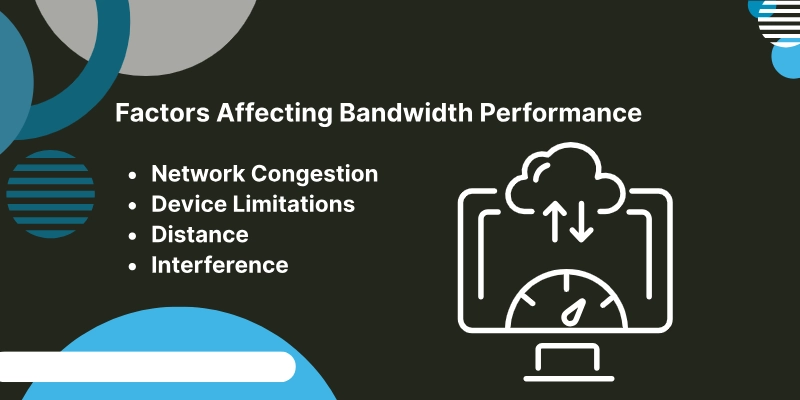What Is Bandwidth and How Does It Work?
Published: 16 Jun 2025
In the modern digital world, terms like bandwidth are frequently mentioned, particularly in discussions about internet speed, data transfer, or networking. But exactly what is bandwidth? How does it affect your online experience? And why should you care about it?
In this blog we will dive deep into the concept of bandwidth, explaining how it works and why it matters.

What Is Bandwidth?
Network bandwidth is the maximum amount of data transmitted through a communication link within a specific time frame. It is expressed in bits, kilobits, megabits, or gigabits per second. Bandwidth reflects the data transfer rate and is often called capacity. However, it does not indicate network speed, a common misunderstanding.
Understanding Bandwidth in Simple Terms
Think of bandwidth as the size of a pipe through which water flows. A larger pipe allows more water to pass through at once. Similarly, bandwidth represents the capacity of a network to handle data transfer. When multiple devices are connected or large amounts of data are transmitted, higher bandwidth is essential to prevent slowdowns or interruptions.

Bandwidth vs. Internet Speed
The terms “bandwidth” and “speed” are often used interchangeably. This misunderstanding is due to advertisements from internet service providers (ISPs) that blur the line by promoting “higher speeds” when they mean increased bandwidth.
In simple terms, speed is the rate at which data travels, while bandwidth is the capacity to support that speed. Using the water pipe analogy again: speed is how fast water flows through the pipe, whereas bandwidth is the amount of water the pipe can carry over a given period.
How Does Bandwidth Work?
Bandwidth determines how much data a connection can send and receive simultaneously. It’s similar to the amount of water a pipe can handle. A larger pipe lets more water flow at once, just like a higher bandwidth allows more data to pass through per second.
The cost of a network connection rises with increased bandwidth. For example, a 1 gigabit per second (Gbps) Dedicated Internet Access (DIA) connection costs more than one with a 250 megabits per second (Mbps) capacity.
Why is bandwidth important?
- Bandwidth is the backbone of online activities.
- In homes or businesses, only a certain capacity is available.
- Limits can come from physical factors like routers, modems, cables, or wireless signals.
- Network administrators or internet providers may also restrict bandwidth.
- Multiple devices share the same connection.
- Some devices, like 4K streaming TVs, use a lot of bandwidth.
- Others, like webinars, consume much less.
- While speed and bandwidth differ, higher bandwidth ensures acceptable speeds for multiple devices.
Example usage:
- Streaming 4K video: High bandwidth.
- Webinars: Low bandwidth.

Factors Affecting Bandwidth Performance
Several factors influence how effectively bandwidth is utilized:
- Network Congestion
- Device Limitations
- Distance
- Interference
How to Measure Bandwidth?
You can measure your bandwidth using tools like:
- Speedtest.net
- Fast.com
- Your Internet Service Provider’s (ISP) Dashboard
These tools provide insights into your download and upload speeds, latency, and jitter.

Types of Network Bandwidth
Below are the different types of bandwidth, each serving a unique purpose in communication systems:
1. Analog Bandwidth
Analog bandwidth is the frequency range over which a signal can be accurately captured, typically defined by the point where the signal amplitude drops by 3 dB. This limitation arises from the input path’s frequency response, affecting amplitude and phase accuracy. With AC coupling, low-frequency signals may be attenuated, while high-frequency loss occurs in all cases. DC coupling allows the bandwidth to extend down to 0 Hz (DC).
2. Digital Bandwidth
In digital networks, bandwidth measures the data transfer rate, such as Mbps or Gbps, representing how much data can move through a connection.
Understanding Bandwidth and Its Calculation
Bandwidth refers to the maximum data a network link can transmit. Its calculation varies by link type:
- Optical Fiber: Uses light waves and time-division multiplexing to carry more data than copper Ethernet, offering higher bandwidth.
- Mobile Networks (LTE/5G): Bandwidth depends on licensed spectrum frequencies, legally managed by operators via FCC or NTIA.
- Wi-Fi: Operates on an unlicensed spectrum, allowing open use. However, overlapping frequencies can reduce bandwidth.
Effective Bandwidth
Effective bandwidth is the maximum reliable data rate a link supports, measured by testing file transfer speeds multiple times.
Calculating Bandwidth Needs
- List all active applications.
- Identify each application’s bandwidth requirement.
- Multiply by the number of users.
- Add the totals for overall bandwidth needs.
For WAN or DIA links in cloud environments, follow the same steps. Local networks generally offer higher bandwidth than internet or WAN connections. Regular monitoring helps identify when upgrades are necessary.
Impact of Low Bandwidth
Insufficient bandwidth slows applications and services, reducing performance. Accurate calculations and monitoring prevent such issues.
Factors Affecting Network Performance
The following are factors affecting network performance, which play a crucial role in determining the speed, reliability, and efficiency of data transmission.
- Bandwidth
- Latency
- Packet Loss
- Jitter
- Network Congestion
- Hardware Limitations
- Software Configuration
- Signal Interference (Wireless Networks)
- Security Threats
- Distance
- Number of Devices
- Protocol Overheads
- Quality of Service (QoS) Settings
- ISP Performance
- Environmental Factors
Common Bandwidth Issues and Solutions
Here are some common bandwidth issues and their solutions to help improve your connection experience:
1. Buffering While Streaming
- Cause: Insufficient bandwidth for high-resolution videos.
- Solution: Reduce the video quality or limit simultaneous streaming.
2. Slow File Downloads
- Cause: Network congestion.
- Solution: Schedule downloads during off-peak hours.
3. Video Call Lag
- Cause: Low upload speeds.
- Solution: Use a wired connection instead of Wi-Fi.
Future of Bandwidth
The digital age has seen a growing demand for more bandwidth, fueled by technological progress and the rise of internet-connected devices. Looking ahead, several emerging trends and technologies are poised to transform the bandwidth landscape and how it is accessed.
- Continued Growth in Data Consumption
- 5G and Beyond
- Advances in Fiber Optics
- Satellite Internet
- Li-Fi
- Quantum Communications
- Software-Defined Networks (SDN)
- Network Slicing
- Compression Technologies
- Edge Computing
- Bandwidth as a Commodity
- Higher Speeds
- 5G and Beyond
- Increased Demand
- Improved Infrastructure
- Global Connectivity
- Adaptive Networks
Conclusion
Bandwidth plays a crucial role in how we experience the internet. By understanding what bandwidth is, how it works, and how to optimize it, you can make informed decisions to improve your online experience. Whether you’re streaming, gaming, or working remotely, ensuring adequate bandwidth is key to staying connected without interruptions.
Please don’t forget to leave a review. Your feedback helps us improve and serve you better.
FAQs
Here are some frequently asked questions (FAQs) to help clarify common queries:
Bandwidth is the maximum capacity your internet connection can handle, measured in Mbps or Gbps. Internet speed refers to how fast data is actually transmitted at a given time — which can be affected by various factors like network traffic and hardware.
Slow speeds despite high bandwidth can be due to network congestion, outdated routers, poor Wi-Fi signals, or too many connected devices. Background apps may also consume bandwidth silently.
Not always. While more bandwidth allows more data to flow, a stable and fast internet experience also depends on factors like latency, signal strength, and equipment quality.
For smooth HD video streaming, a minimum of 5 Mbps is suggested. For 4K or Ultra HD streaming, you’ll need at least 25 Mbps to avoid buffering and maintain quality.
Yes, when many users or devices are connected to the same network, they share the available bandwidth. This can slow down performance, especially during peak usage times.
You can improve speed by upgrading your router, placing it in a central location, using Ethernet instead of Wi-Fi, and limiting the number of connected devices.
Internet speed can vary due to factors like peak traffic hours, ISP throttling, weather conditions (for satellite internet), or interference from nearby networks.
It depends on your usage. Upload speed matters for video calls, online gaming, cloud backups, and uploading large files. For streaming or browsing, download speed is more critical.
Latency is the delay before data begins to transfer. High latency can cause lag, which is especially noticeable in online gaming, video conferencing, or real-time communication

- Be Respectful
- Stay Relevant
- Stay Positive
- True Feedback
- Encourage Discussion
- Avoid Spamming
- No Fake News
- Don't Copy-Paste
- No Personal Attacks

- Be Respectful
- Stay Relevant
- Stay Positive
- True Feedback
- Encourage Discussion
- Avoid Spamming
- No Fake News
- Don't Copy-Paste
- No Personal Attacks





